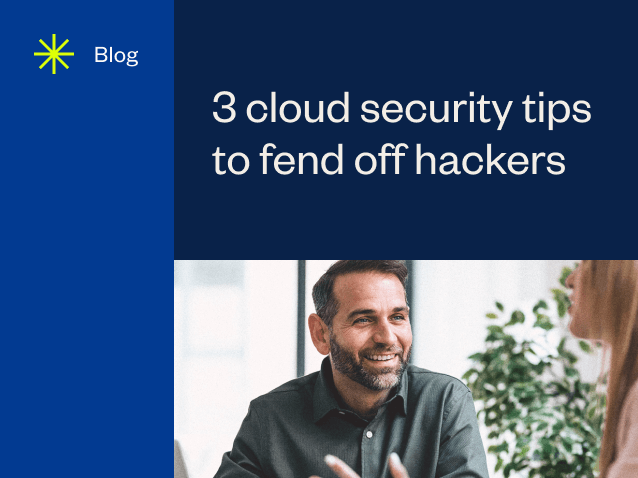3 Cloud Security Tips to Help Your Organisation Fend off Hackers

Today’s hackers are setting their sights on cloud resources. Just recently hacker group Cloaked Ursa – also known as APT29, Nobelium, and Cozy Bear — executed a massive effort targeting Google Drive and Dropbox.
Cloud breaches are leaving companies across industries vulnerable to hacks. In the last few months of 2022, password manager LastPass suffered a data breach when hackers gained access to a third-party cloud storage service and HR software maker Sequoia reported a breach of its cloud storage repositories, which put customers’ sensitive personal data at risk.
How can you prevent something similar from happening within your organisation? The most important thing to do is to identify vulnerabilities exist. For most organisations, that includes:
- The Human Element (People)
- Logging and Monitoring procedures
- App integrations and 3rd party components or libraries
In this blog, we’ll provide cloud security tips to help your organisation strengthen these vulnerable areas to decrease the likelihood of an attack.
Cloud Security Tip #1: Educate Employees to Prevent Social Engineering Attacks
Many breaches involve a form of social engineering, where hackers exploit the human element to trick people within an organization into providing some sort of access to sensitive data. In fact, in a recent survey, 75 percent of respondents cited social engineering/phishing attacks as the top threat to cybersecurity at their organization.
Phishing is a very common strategy and most often takes the form of emails, website forms, or phone calls that encourage readers to click a link that is used to install malware or reveal personal information like credit card numbers, social security numbers, or account login credentials. Hackers have become quite sophisticated in their efforts, impersonating colleagues or other reputable sources to deceive employees.
Organization’s must prioritize educating their employees about these attacks, so breach attempts can be more easily identified and thwarted. It’s helpful to share examples of phishing attempts throughout your company so employees can better identify authentic communications.
It’s also important to educate employees on an ongoing basis. Hackers are constantly updating/changing their methods — they switch methods once a new one is proven to be effective. With that in mind, your education efforts for employees (also known as security awareness training) should focus on relevant current attacks/threat vectors being used by bad actors.
Cloud Security Tip #2: Use Automation to Mitigate Logging and Monitoring Vulnerabilities
Hackers often take advantage of insufficient logging and monitoring procedures, which give them more time to penetrate systems unnoticed. This is a huge advantage for them. With more time to discover exploitable vulnerabilities, hackers can increase the likelihood of maximum damage.
While hackers poke around your systems, your organisation may not even notice a system anomaly that needs to be investigated.
The most common insufficiencies we see across organisations include:
- Logging level configuration issues. When logging levels aren’t set correctly or are set too low, you can miss alerts about unexpected activity that require investigation.
- A lack of log sources configured or onboarded. Without log sources, your organisation has no visibility into critical areas of your infrastructure — and therefore can’t detect suspicious activity.
- Insufficient error messages. When error messages lack key details, it’s impossible to contextualize anomalies and decide if they need to be investigated.
Consider using automated solutions to improve your logging and monitoring processes. This will allow you to notice and respond to anomalies at scale.
Cloud Security Tip #3: Conduct Penetration Tests to Secure App Integrations
Web applications are particularly vulnerable to attacks. Nowadays there are so many integrations that threat actors can take advantage of. Particularly, threat actors have been able to move laterally across the cloud with applications that were either not developed securely or have vulnerabilities within the integrations themselves.
To monitor your app integrations, it’s essential to conduct regular penetration tests. Your organization should regularly test to identify weaknesses in web applications before an attacker identifies them. This includes testing to ensure integrations are supported and updated.
A penetration test will show if there are unintended vulnerabilities that can be used to move laterally across different parts of your organisation’s cloud, so you can perform the necessary remediations immediately.
Secure Your Cloud Resources Today
Don’t wait to secure your cloud resources. Hackers continue to become more sophisticated with new strategies to discover vulnerabilities within any environment and target sensitive information. A breach can cause financial losses, reputational damage, and result in expensive GDPR fines and penalties for your organization.
Start the process to protect your resources today by conducting a penetration test to identify your biggest areas of concern.
Watch this video so you know what to expect during the process then contact the experts at A-LIGN to set up your first test.





